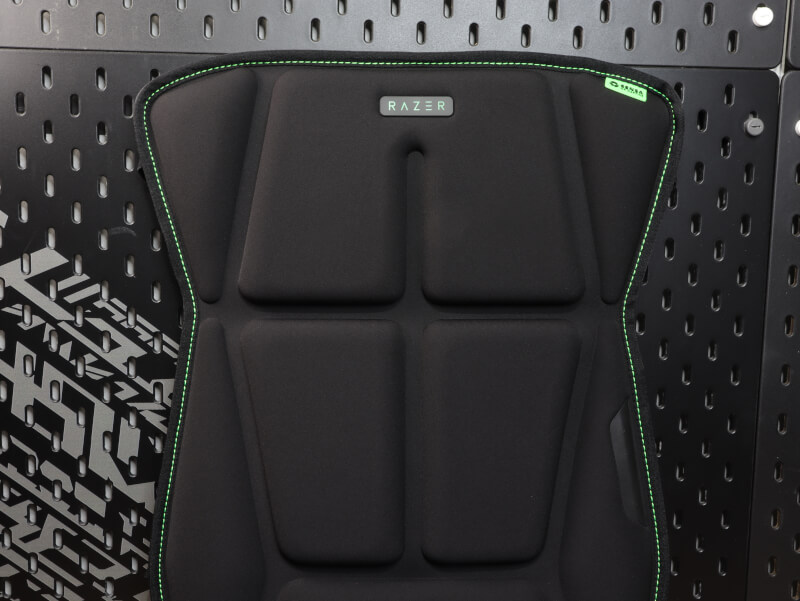Razer Freyja gaming cushion

Before we move on to take a closer look at the Freyja from Razer, I have found specifications.
Specifications:
- AC adapter
- Haptics tactile Transducer: 6x Voice coil actuators
- Connectivity: 2.4 GHz wireless, BLE (Swift pair, google fast pair)
- Device compatibility: PC (Synapse), Android (Nexus App)
- Recommended user height: 160-200 cm
- Product weight: <3 kg
All about the Razer Freyja
Razer Freyja is a haptic add-on that can be mounted on your gaming chair and provides dynamic feedback using Sensa HD technology. It creates a tactile experience that follows the rhythm of music, action in games and movies, making the entertainment more intense and immersive. For optimal comfort and correct fit, Freyja is recommended for users of an average height between approx. 160 cm and 200 cm, so that the feedback mechanism is best placed in relation to the user's back and body.
The Razer Freyja has a modern, functional design that integrates haptic elements without compromising on aesthetics. The cushions in the system are shaped to support natural body curves, improving ergonomics by supporting a correct sitting position during longer sessions. The pads are made from high-quality material that provides both comfort and durability, while ensuring that feedback from Sensa HD technology is evenly distributed for a balanced, immersive experience in gaming and entertainment.
The Razer Freyja's control panel, discreetly placed on the side, gives the user easy access to adjustments during use. Here you can turn haptic functions on and off, adjust the intensity of the feedback and switch between input modes. The connection can be set to either 2.4 GHz connection to PC for minimal delay or Bluetooth for use with the phone, ensuring flexibility across devices and control over the experience with a single tap.
Razer Freyja is easily connected to constant power via an AC adapter, ensuring that the haptic technology can deliver stable vibrations and responses without interruption. The adapter connects to a dedicated port, which provides an uninterrupted power supply, so that the device is always ready to deliver an intense and continuous experience during both gaming, movies and music.
The Razer Freyja experience
Just under a year ago, Razer presented a new project: a chair add-on that provides haptic feedback so that you not only hear the game, but also physically feel it. With vibrations that simulate everything from a car rattling on the road to explosions on a battlefield, the gaming experience has become more physical.
Now that the project has become the finished product, Freyja, I have had the opportunity to test it. In games like shooters and racers, Freyja adds fun and intense tactile feedback, especially at high intensity, creating a deeper gaming experience that involves the whole body.
I have tested the Freyja in the same way as I would normally test a headset, but here it is less about the sound image itself and more about the vibrations that accompany the sound. Haptic feedback depends on the sound frequency, so the experience is shaped by the sound in the game.
In games where you were shot or an explosion happened, it worked really well, and especially when it was turned up a lot, it gave a fun feeling that got me more into the game.
The same with racing, where Forza Horizon was allowed to be thrashed. It just required a downward adjustment of the music, which was in the background, but when it was in place. I got a good feedback in the seat when the car raced off, and especially when I hit places that were bumpy, it could be felt in the seat.
Of course, I also had to try some music, and here the obvious choice was AC/DC with War Machine. Again, the music confirms that the haptic feedback is an addition of a bass without affecting the whole home. Because it gave both a fun and different feeling to sit and listen to that track, both with Freyja and the Kraken v4 Pro, when the vibrations went out in time with the bass in the music.
Price
There are no stores that have had Freyja during the test. But it is possible to buy directly from Razer, at a price of $299.
If you want to find more information about Freyja from Razer, you can click on the banner above.
Conclusion
Razer Freyja brings an exciting new dimension to gaming and audio experiences, making games and music more physical and immersive through haptic feedback. The test shows that Freyja works very well in action-packed games such as shooters and racers, where the vibrations increase the intensity and realism by providing a bodily reaction to explosions and rough roads. Especially at high intensity, the feedback becomes fun and engaging, and the experience changes so that it feels like a more complete immersion. Also during music playback, like in bass-heavy tracks like War Machine by AC/DC, Freyja works surprisingly well. It adds an extra dimension to the soundscape without requiring high volume in the room, providing a different but enjoyable experience.
With its ergonomic design and adjustable intensity levels, Freyja provides comfort for longer sessions, making it suitable for both gaming and music. The advantages are many, but there are also disadvantages: Freyja requires constant power via an AC adapter, which limits mobility and makes the set-up a little more clumsy with a fixed cord. In addition, the haptic experience depends on the sound image, specifically the deeper bass frequencies, which means that not all games and sound scenes will be able to make optimal use of the feedback.
The price of $299 makes Freyja a relatively expensive addition, which therefore appeals mostly to users who want extra immersion in games and sound. For the right user, however, Freyja can be a fun and unique investment that improves experiences across media types. All in all, Freyja delivers on its promise of a deeper gaming experience and is highly recommended for those who want to feel the action quite literally. I end up giving Freyja a score of 8 out of 10. But definitely an addon if you don't know what to spend your money on or are an enthusiast about your game and want to add an extra dimension to the game.
Benefits
- Unique gaming experience
- Haptic feedback
- Adjustable intensity level
- Ergonomic design
Disadvantages
- Constant current, which means a wire that hangs in the chair
- Depending on the bass frequency
- Price
Score: 8

Latest gadgets
-
19 Sepgadgets
-
23 Maygadgets
LaserPecker LP5 Laser Engraver
-
01 Maygadgets
Swytch launches Swytch Max+ Kit
-
10 Margadgets
DJI AIR 3S
-
03 Margadgets
Razer Wolverine V3 Pro
-
21 Febgadgets
OBSBOT Tiny 2 SE
-
13 Febgadgets
Corsair launches Platform:4
-
17 Jangadgets
Nerdytek Cycon3
Most read gadgets
Latest gadgets
-
19 Sepgadgets
DJI launches Mini 5 Pro
-
23 Maygadgets
LaserPecker LP5 Laser Engraver
-
01 Maygadgets
Swytch launches Swytch Max+ Kit
-
10 Margadgets
DJI AIR 3S
-
03 Margadgets
Razer Wolverine V3 Pro
-
21 Febgadgets
OBSBOT Tiny 2 SE
-
13 Febgadgets
Corsair launches Platform:4
-
17 Jangadgets
Nerdytek Cycon3







